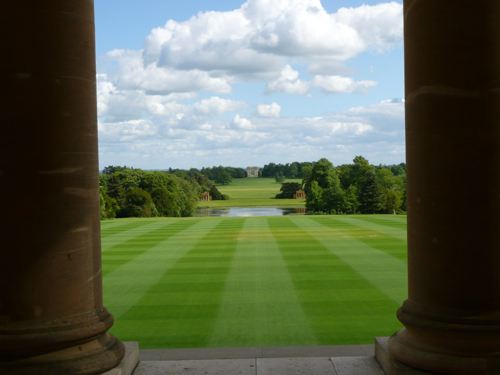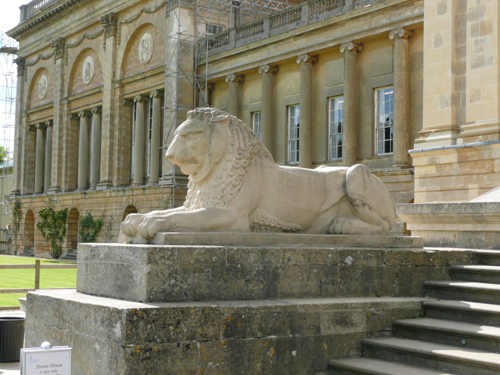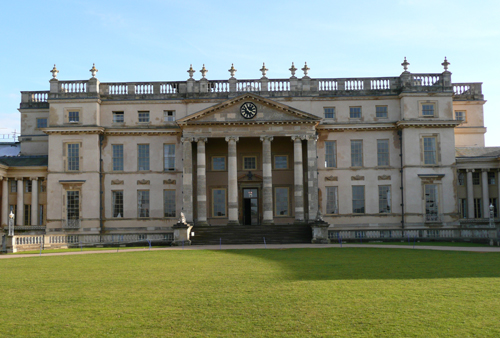
Introduction
Last year I carried out an analysis of the early decorative schemes in a number of the prime rooms at Stowe House. The house, which has been the home of Stowe School since 1923 is currently undergoing a lengthy six phase restoration programme by the Stowe House Preservation Trust. Phases 1 and 2 have recently been completed. This has included the restoration of the magnificent Marble Saloon
This blog post will consist of two parts. This first giving a brief account of the history of the building and its occupants and the second on some of the things that I discovered during my analysis of the paint.

The Temple family acquired the estate in 1593. In 1677 Sir Richard Temple 3rd Bart (1634-97) built a brick house, which remains the core of the existing building. His son, also Richard (1675-1749), inherited the house in 1697. He was a soldier, rising to the rank of Lieutenant General, and finally becoming Viscount Cobham in 1718. He brought in John Vanbrugh, who extended the house, and Charles Bridgeman, who carried out extensive landscaping of the estate.
Stowe was inherited by Lord Cobham’s nephew, Richard Grenville (1711-79). He soon became Earl Temple and was described as being the richest man in England. Much of this wealth was used to enhance Stowe – the existing north and south fronts and most of the interiors date from this time.

Earl Temple’s nephew, George Grenville (1753-1813) was made Marquess of Buckingham. His eldest son, Richard (1776-1839) achieved the family’s long-standing ambition of a dukedom, being made Duke of Buckingham and Chandos in 1822. By the end of his life overspending had led to a number of economies, which resulted in the sales that started in 1833 and the house being shut up.
The second Duke inherited his father’s extravagance and became known as the “Greatest Debtor in the World”. His debt was such that in 1848 the contents of the house were sold over forty days and shortly after he occupied a Grace and Favour apartment at Hampton Court Palace.

Richard, the third Duke (1823-89) attempted to restore the family’s fame and fortune by taking on a long list of public appointments. He died unexpectedly in 1889 and most of his titles either died with him or transferred out of the immediate family. His daughter, Lady Kinloss, was prepared to sell Stowe on her father’s death, but no buyer could be found. She, therefore, let the house to the Comte de Paris, the claimant to the French throne. He died in 1894 and the house was again empty until the widowed Lady Kinloss occupied it from 1901 to 1907.
Her eldest son, the Master of Kinloss, inherited the house in 1908, but he was killed in the first year of the Great War. Stowe passed to his brother the Rev. the Hon. Louis Morgan-Grenville, who put it up for sale in 1921. The buyer was a Mr Harry Shaw, who had hoped to present the house to the nation. However he was unable to raise the necessary endowment and was forced to sell it the following year.

Stowe School, has been the guardian of the house since 1922. Since that time some of the family portraits and other items associated with the house have been bought back and are now on display in the house. Unable to continue with the maintenance and restoration of the house and garden, the School gave Stowe Landscape Gardens to the National Trust in 1989. In 1997 the Stowe House Preservation Trust was founded with the responsibility for repairing and presenting the house. With the assistance of the Heritage Lottery Fund, English Heritage and the World Monument Fund amongst others a programme of restoration is now taking place.
More views of the North front can be seen in these two short film clips:
This one was taken by me while working on the Library:
(Much of this has been taken from Michael Bevington’s Stowe House. Paul Holberton, 2002.)
Patrick Baty

Click for more information on what I do.
The Stowe House Preservation Trust was founded in 1997 in order “to restore and preserve Stowe House for the benefit of the nation and the public.” The school remains as a tenant and the house is opened to the public on more than 200 days per year.
View Larger Map












No comments yet. Be the first!